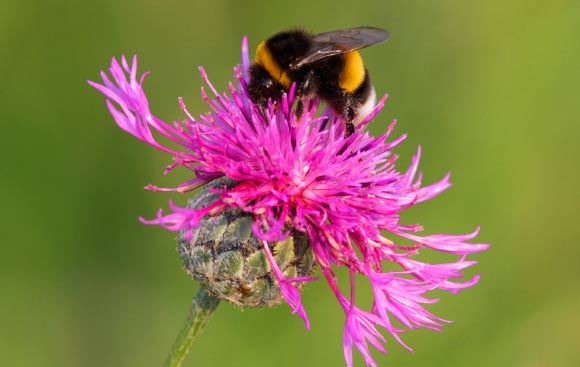String pulling is a popular problem-solving task for investigating cognitive abilities in apes and birds, but has never been tested in insects. Now, buff-tailed bumblebees (Bombus terrestris) have joined the club, according to a study by researchers at Queen Mary University of London, UK.
The team’s results show that rare innovator bumblebees were able to solve the problem of pulling the string to reach a sugar water reward by themselves while most others could learn to pull the string when trained.
Naïve bumblebees were then able to learn the task by observing a trained demonstrator insect while this skill was passed down through several generations of learners, ensuring its longevity in the population.
“We found that when the appropriate social and ecological conditions are present, culture can be mediated by the use of a combination of simple forms of learning,” said study lead co-author Dr. Sylvain Alem.
“Thus, cultural transmission does not require the high cognitive sophistication specific to humans, nor is it a distinctive feature of humans.”
“Despite the obvious differences between humans and other animals, understanding social learning and culture in animals holds a key to understanding the evolutionary roots of the peculiarities of social learning and culture in humans,” said lead co-author Dr. Clint Perry.
To test the bumblebees’ capacity for learning string pulling, they were presented with three artificial blue flowers with a string attached to each flower and placed under a small transparent Plexiglas table.
Initially 23 bumblebees, of a group of 40, were able to be trained in a stepwise manner by placing the flowers and strings at progressively distant positions under the table.
Another group of insects was given the opportunity to solve the task spontaneously, without any training, and only two of 110 were successful suggesting it is a rare occurrence.
Naïve bumblebees were then allowed to observe trained individuals pulling the string from a distance and 60% of them successfully learned the skill.
Finally trained bumblebees were placed in colonies and the team observed that the technique spread successfully to a majority of the colony’s worker bumblebees.
“We are ultimately interested in finding out what might be possible neural solutions to underpin such refined skills in bumblebees,” said study senior author Prof. Lars Chittka.
“How can they do it with such small brains, and how can their miniature nervous systems manage such a diversity of behaviors and cognitive tasks?”
“We are exploring this through modeling information processing in parts of the insect brain, and we find that often, exceedingly difficult tasks, for example in visual pattern recognition or floral scent learning, can be solved with extremely simple neural circuits,” he said.
“We are still a long way from understanding the required neural circuitry for string-pulling, however.”
The team’s results were published in the journal PLoS Biology this week.
_____
S. Alem et al. 2016. Associative Mechanisms Allow for Social Learning and Cultural Transmission of String Pulling in an Insect. PLoS Biol 14 (10): e1002564; doi: 10.1371/journal.pbio.1002564








